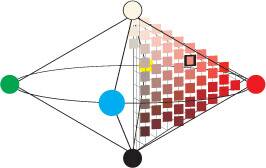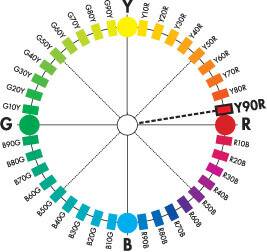NCS – A NATURAL PART OF MANKIND
Research has shown that everybody carries the NCS model in their brain. Where other systems use meaningless numbers, the NCS notation gives an exact description of the colour which we see. With NCS, it is possible to denote all the 10 million colours which the eye can distinguish.
NCS has, since its inception in 1978, become one of the leading and most used colour systems in the world. It is used today within all branches where it is necessary to communicate colour. NCS is already the national standard in Spain, Sweden and Norway. These are some of the features which makes NCS more than just a colour card.
THE NCS IS AS SIMPLE AS THIS:
NCS – NATURAL COLOUR SYSTEM™ is a logical colour system which builds on how the human being sees colour. With NCS all the imaginable surface colours can be described and given an unambiguous NCS notation.
The six pure colours which are the basis of the built-in ability of humans to characterise different colours are white W, black S, yellow Y, red R, green G, blue B – the six elementary colours. NCS colour notations are based on how much a given colour seems to resemble two or more of these six elementary colours.
In the NCS notation 2030-Y90R, for example, 2030 indicates the nuance. This means the degree of resemblance to black S and to the maximum hue C. In this case, 20% blackness (S) and 30% chramaticness (C) of a maximum of 100%. The outstanding balance to reach 100% is 50%, which is the whiteness W. The hue Y90R indicates the percentage resemblance of the colour to 2 chromatic elementary colours, here Y and R. Y90R means yellow with 90% redness.
Purely grey colours lack colour hue and are only given nuance notations followed by – N as neutral. 0500-N is white and is followed by 1000-N, 1500-N, 2000-N and so on to 9000-N which is black. The letter S preceding the complete NCS notation (S 2030-Y90R) means that the NCS sample is from the Second Edition.
NCS – MUCH MORE THAN A COLOUR CARD
NCS – A natural part of mankind NCS builds on decades of scientific research in an interdisciplinary environment of designers, engineers and psychologists. At the root lie Leonardo da Vinci’s ideas, which over the centuries have been developed and finally resulted in NCS. Research has shown that everybody carries the NCS-model in the brain. Where other systems use meaningless numbers, the NCS notation gives an exact description of the colour which we see. With NCS, it is possible to denote all the 10 million colours which the eye can distinguish.
Thinks globally, acts locally
NCS is represented in 24 countries by a network of distributors. These support your local market and have a complete NCS-stock of colour samples and other products. They supply training material, education and knowledge. NCS has, since its inception in 1979, become one of the leading and most used colour notation systems in the world. It is used today within all branches where it is necessary to communicate colour. NCS is already the national standard in Norway, Spain, South Africa and Sweden. These are some of the features which makes NCS much more than just a colour card.
THE NCS IS AS SIMPLE AS THIS:

NCS-Natural Color System®© is a logical colour system which builds on how the human being sees colour. With NCS, all imaginable surface colours can be described and given unambiguous NCS notations. The six pure colours which are the basis of the built-in ability of humans to characterize different colours are white W, black S, yellow Y, red R, blue B and green G – the six elementary colours. NCS colour notations are based on how much a given colour seems to resemble these six elementary colours. In the NCS designation 1050-Y90R, for example, 1050 indicates the nuance, i.e. the degree of resemblance to black S and to the maximum hue C; in this case, 10% blackness (s) and 50% chromaticness (c). The hue Y90R indicates the percentage resemblance of the colour to two chromatic elementary colours, here Y and R. Y90R means yellow with 90% redness. Purely grey colours lack colour hue and are only given nuance notations followed by -N as neutral. 0300-N is white and this is followed by 0500-N 1000-N, 1500-N, and so on to 9000-N, which is black. The letter S preceding the complete NCS notation (S 1050-Y90R) means that this is a standardized NCS sample from NCS Edition 2.

NCS Colour Space

In this three-dimensional model, called the NCS Colour Space, all imaginable surface colours can be placed and thus be given an exact NCS notation.
In order more easily to understand the parts included in the NCS notation, the double cone is divided into two twodimensional models, the NCS Colour Circle and the NCS Colour Triangle.
NCS Colour Circle

The NCS Colour Circle is a horisontal section through the middle of the colour space where the four chromatic elementary colours are placed like the points of a compass.
Each quadrant between two elementary colours has been divided into 100 equal steps. In the figure, the hue Y90R, yellow with 90% redness, has been marked.
NCS Colour Triangle

The NCS Colour Triangle is a vertical section through the colour space. The base of the triangle is the grey scale from white (W) to black (S) and the apex of the triangle is the maximum chromaticness (C) in the current hue, here Y90R.
Colours of the same hue can have different blackness or chromaticness values, i.e. different nuances. This can be illustrated in colour triangles, where the scales of which are divided into 100 steps. In the figure, the nuance 1050 has been marked, a colour with 10% blackness and 50% chromaticness.
